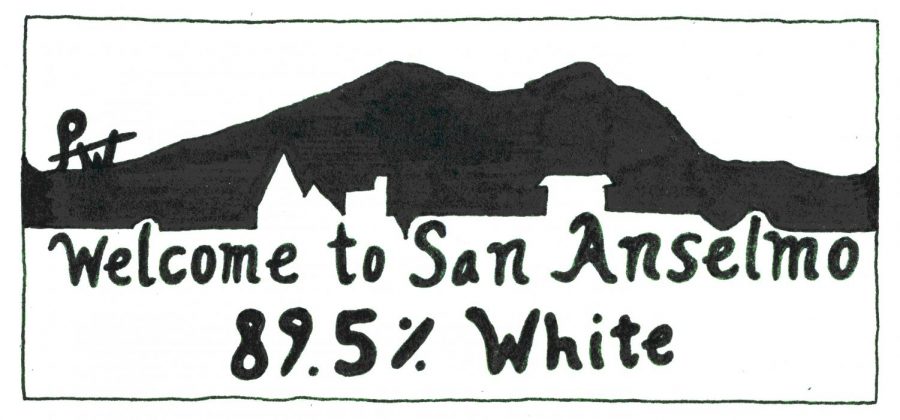San Anselmo’s lack of diversity not an accident
An original Illustration by Pace Buchan intertwines the town’s homey logo with it’s low diversity
December 19, 2019
Any student at Drake is well aware of the demographics. Walking through the corridors, the homogeneity of the student body is distinct.
“We have a very homogenous culture because of our lack of diversity,” said David Cho, a member of Drake SOAR (Students Organized for Anti-Racism). “People try to dress and act in very similar manners. I think it prevents people from acknowledging different things that other people can bring into the community,” Cho said.
San Anselmo is 89.5 percent white, according to recently compiled data from 2017 data from the U.S. Census Bureau, making it the least diverse town in the Bay Area and the whitest city in California.
This characteristic of San Anselmo and of greater Marin County is not a new phenomenon. A lack of diversity to the point of unenforced segregation remained a problem even after the civil rights movement and has continued ever since.
According to the Department of Housing and Urban Development (HUD), the Fair Housing Act “protects people from discrimination when they are renting or buying a home, getting a mortgage, seeking housing assistance, or engaging in other housing-related activities.”
In 2011, a HUD study found that Marin County failed to meet standards of affordable housing for people of color. It found examples of segregation, including that 70 percent of Latino residents lived in a two square mile area around San Rafael’s canal area.
There is no single group, event, or law to blame for such segregation. Decades of different policies and social patterns have shaped demographics in Marin. Before the civil rights movement, housing discrimination was legal and common. However, even after Civil Rights legislation was passed, discrimination continued in many areas of the U.S. through redlining, a practice in which banks deny mortgage loans to individuals based on their race.
In these cases, banks decided if certain neighborhoods were desirable based on their demographics. In order to keep housing costs up, they maintained the “desirability” of neighborhoods by keeping them white. They did this by drawing a literal line on a map around neighborhoods set aside for the white population, and creating unusually high interest rates for the neighborhoods outside of this white line. The result was higher costs for people of color.
Of course, this form of discrimination wasn’t only sustained by banks and institutions. The concept of less diverse neighborhoods being more “desirable” stemmed from a genuine preference of affluent white people to be surrounded by people like them and to live away from communities and people of color.
According to Drake social studies teacher David Gutfeld, this public sentiment played more of a role in segregation than historical and pre-civil rights discrimination practices, specificallyin the decision to exclude Marin County from Bay Area Rapid Transit’s (BART’s) domain.
One reason often attributed to Marin’s lack of diversity is the sparse public transportation options, specifically the absence of a BART route into Marin. Without sufficient public transportation, low income residents who might not be able to afford their own cars have limited options for transit.
“Originally when BART was being decided upon back in the early 60s they took it off the ballot because organizers thought that if Marin county was allowed to vote in it, they wouldn’t be able to pass the legislation to create BART,” Gutfeld said. According to Gutfeld, one reason there is no BART in Marin is that residents were afraid of bringing in people from other communities and what that could mean.
“They felt that other people- and they used code words ‘other people’- coming into Marin County would make it more dangerous and would bring down property values,” Gutfeld said. Marin County remains one of the most expensive places to live in the country.
Gutfeld claims that public influence on the perpetuation of segregation comes from a desire to maintain status and power- status and power gained from whiteness. Even today, this can be seen in the current housing policy. According to a publication by the Othering and Gathering Institute at the University of California Berkeley, “a small number of clustered public housing or affordable housing communities are home to many of the people of color in the county. Anti-development policies strictly regulate where new or affordable housing can be built, helping maintain patterns of racial segregation.”
“Today it’s not like anybody goes out of their way to say ‘I don’t want people of color living near me.’ But we create a system that does that.” said Gutfeld.
Until the idea that diversity is undesirable and unsafe goes away for good, and real legislative action is taken to desegregate local communities, San Anselmo will likely remain the whitest town in California.




Joseph Richardson • Jan 21, 2021 at 11:53 PM
How about San Rafael? The Canal District? I know dozens of Latinos in Marin. Tell me who thinks that diversity is dangerous. Tell me one politician who has said that. The entire Democratic Party is behind the notion that it is good. And so is parts of the Republican.
Joseph Richardson • Jan 21, 2021 at 11:50 PM
Who cares? If you don’t like it then move. That’s what I’m doing.
Shannon McCalla • Sep 11, 2020 at 5:10 PM
San Anselmo is not more diversified because it’s full of affluent people, who historically are more white than any other ethnicity. It would be interesting to hear about the politics of class, as well as the politics of race.
Kevin Saavedra • Jan 8, 2020 at 5:47 PM
There is a straightforward reason BART does not serve Marin: bridge tolls.
Marin County could have had BART, but backroom politics got in the way
https://www.sfgate.com/local/article/Marin-County-BART-Golden-Gate-Bridge-study-14364699.php